Papers by Bibiana A Bilbao
Bombero indígena: La importancia rol de los brigadistas indígenas Pemón en la construcción del manejo intercultural del fuego en el Parque Nacional Canaima, Venezuela
The smoke clears… A small group returns to their homes for lunch. A few hectares smoulder, safely... more The smoke clears… A small group returns to their homes for lunch. A few hectares smoulder, safely. This area won't burn again for some time. Alongside other patches burned at different times, the whole area is safe from the threat of a wildfire. Nutrients are returned to the soil. Fresh shoots will soon emerge for livestock. Snakes have fled from fields and homesteads; cattle ticks are gone, as well as other pests. The land is rejuvenated. This was the traditional way that people across the world managed fire, since the beginning of humanity.

Biodiversity, Fire, and Herbivory in Tropical Savannas
Ecological studies, 1996
The main determinants of tropical savannas are plant available moisture (PAM) and plant available... more The main determinants of tropical savannas are plant available moisture (PAM) and plant available nutrients (PAN). Fire (F) and herbivory (H) are secondary determinants in a hierarchy of factors which produce the characteristics of any particular savanna (Solbrig 1991). While the biodiversity of a savanna area will be influenced by the biogeographic pool of species available to the region at any given time, the structure and productivity of the savanna are controlled by PAM and PAN, which in turn also influence biodiversity. Fire and herbivory then modify biodiversity directly through the mortality of individuals and indirectly through effects on the resources by individuals using different fuel types. Also biodiversity, through the range of food resource qualities and quantities, helps to determine the impact level of herbivory on the ecosystem.
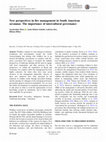
AMBIO: A Journal of the Human Environment, May 11, 2018
Wildfires continue to cause damage to property, livelihoods and environments around the world. Ac... more Wildfires continue to cause damage to property, livelihoods and environments around the world. Acknowledging that dealing with wildfires has to go beyond fire-fighting, governments in countries with fireprone ecosystems have begun to recognize the multiple perspectives of landscape burning and the need to engage with local communities and their practices. In this perspective, we outline the experiences of Brazil and Venezuela, two countries where fire management has been highly contested, but where there have been recent advances in fire management approaches. Success of these new initiatives have been measured by the reduction in wildfire extent through prescribed burning, and the opening of a dialogue on fire management between government agencies and local communities. Yet, it is clear that further developments in community participation need to take place in order to avoid the appropriation of local knowledge systems by institutions, and to better reflect more equitable fire governance.
Indigenous land use and land cover changes in the national park of Canaima, Venezuela: Pemón Sector II Kamarata
Proyecto académico sin fines de lucro, desarrollado bajo la iniciativa de acceso abierto
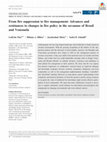
The Geographical Journal, Apr 10, 2018
Anthropogenic fire has long shaped landscapes and livelihoods in South American savanna environme... more Anthropogenic fire has long shaped landscapes and livelihoods in South American savanna environments. With the growing recognition of the failures of fire suppression policies and the relevance of local peoples' practices, the Brazilian and Venezuelan governments have begun to shift to fire management policies in savanna ecosystems. Using case studies from protected areas in Cerrado and Gran Sabana, and results from two multi-stakeholder meetings held in Parupa (Venezuela) and Brasilia (Brazil), we identify advances, resistances and challenges to inter-cultural fire management in both countries. We show that the two regions host pioneer experiences in collaborative research based on improved dialogue and knowledge exchanges between scientists, institutions, Indigenous and local communities as well as fire management implementation including "controlled" and "prescribed" burnings. However, in some places, narrow understanding of the complexity and historical dynamics of local fire practices and the strong resistance to recognise the value of traditional fire knowledge might restrain effective participation of local communities. We argue that more collaborative research is necessary to support community owned solutions for intercultural and participative fire management in changing environmental and socio-cultural contexts.
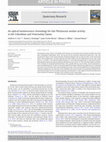
Quaternary Research, Mar 1, 2016
The lowland savannas (Llanos) of Colombia and Venezuela are covered by extensive aeolian landform... more The lowland savannas (Llanos) of Colombia and Venezuela are covered by extensive aeolian landforms for which little chronological information exists. We present the first optically stimulated luminescence (OSL) age constraints for dunes in the Llanos Orientales of lowland Colombia and new ages for dunes in the Venezuelan Llanos. The sampled dunes are fully vegetated and show evidence of post-depositional erosion. Ages range from 4.5 ± 0.4 to 66 ± 4 ka, with the majority dating to 27-10 ka (Marine Isotope Stage 2). Some dunes accumulated quickly during the last glacial maximum, although most were active 16-10 ka. Accretion largely ceased after 10 ka. All dunes are elongated downwind from rivers, parallel with dry season winds, and are interpreted as source-bordering features. As they are presently isolated from fluvial sediments by gallery forest it is proposed that activity was associated with a more prolonged dry season, which restricted gallery forest, leading to greater sediment availability on river shorelines. Such variability in dry season duration was potentially mediated by the mean latitude of the ITCZ. The cessation of most dune accretion after ca. 10 ka suggests reduced seasonality and a more northerly ITCZ position, consistent with evidence from the Cariaco Basin.
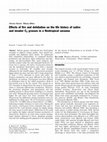
Oecologia, Jun 16, 1999
African grasses, introduced into Neotropical savannas to improve forage quality, have spread succ... more African grasses, introduced into Neotropical savannas to improve forage quality, have spread successfully and displaced native plants. To understand their competitive relationships, we compared biomass production and allocation, plant architecture and phenology, net photosynthesis (Pn), water relations, and nutrient content under ®re and simulated herbivory between two C 4 grasses, the native Trachypogon plumosus and the introduced Hyparrhenia rufa from a seasonal savanna in Venezuela. All variables were strongly in¯uenced by the rainfall regime. Hyparrhenia produced bigger plants (in mass and size) with a large proportion of mass (>75%) allocated to leaves and culms. Its biomass production was more aected by ®re than by defoliation. In contrast, Trachypogon was more aected by defoliation than by ®re which promoted a¯ush of leaf growth even in the dry season. Fire caused up to 85% mortality in Hyparrhenia but none in Trachypogon where it increased in¯orescence production. However, ®re promoted abundant seed germination and fast seedling growth in Hyparrhenia, enabling it to colonize new areas. During the growing season Trachypogon had higher Pn and lower leaf water potential (Y) than Hyparrhenia but dierences among treatments were not signi®cant for either grass. Pn of Trachypogon ceased at a lower Y (A3.0 MPa) than in Hyparrhenia (A2.0 MPa), indicating its higher tolerance to water stress. During the dry season, Trachypogon leaves remained alive and retained low Pn. Leaf nutrient content was higher during the rainy season in both species. Dierences in Pn could not explain the higher seasonal biomass production of Hyparrhenia. However, its water stress evasion strategy, larger biomass allocated to leaves, abundant germination and fast seedling growth appeared to be responsible for the success of Hyparrhenia as an invader of Neotropical savannas.
Significance of nutrient relations and symbiosis for the competitive interaction between grasses and legumes in tropical savannas
Elsevier eBooks, 1991
ABSTRACT
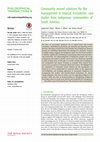
Philosophical Transactions of the Royal Society B, Jun 5, 2016
Fire plays an increasingly significant role in tropical forest and savanna ecosystems, contributi... more Fire plays an increasingly significant role in tropical forest and savanna ecosystems, contributing to greenhouse gas emissions and impacting on biodiversity. Emerging research shows the potential role of Indigenous land-use practices for controlling deforestation and reducing CO 2 emissions. Analysis of satellite imagery suggests that Indigenous lands have the lowest incidence of wildfires, significantly contributing to maintaining carbon stocks and enhancing biodiversity. Yet acknowledgement of Indigenous peoples' role in fire management and control is limited, and in many cases dismissed, especially in policy-making circles. In this paper, we review existing data on Indigenous fire management and impact, focusing on examples from tropical forest and savanna ecosystems in Venezuela, Brazil and Guyana. We highlight how the complexities of community owned solutions for fire management are being lost as well as undermined by continued efforts on fire suppression and firefighting, and emerging approaches to incorporate Indigenous fire management into market-and incentive-based mechanisms for climate change mitigation. Our aim is to build a case for supporting Indigenous fire practices within all scales of decision-making by strengthening Indigenous knowledge systems to ensure more effective and sustainable fire management. This article is part of the themed issue 'The interaction of fire and mankind'.

Plausibility of New Paradigms in Terrestrial Nitrogen Cycle
EGUGA, Apr 1, 2012
ABSTRACT During the last decade, progress in the understanding of terrestrial nitrogen cycle stre... more ABSTRACT During the last decade, progress in the understanding of terrestrial nitrogen cycle stress the challenge of rethinking our conceptual model of global nitrogen cycle in a changing world. Our current N cycle paradigms postulate: 1) inorganic soil N as the main source of plant N, since the plant ability to take up organic N is uncommon in nature, 2) atmosphere as the solely source of new N, disregarding the possibility of bedrock N as an important nutritional source, and 3) symbiotic N fixing in plant as the key process introducing new N from the atmosphere, overlooking biological crusts and N fixing free living organisms as important players. Since recent evidence suggest an important role of bedrock N, biological crusts and N fixing free living organisms as well as a wider distribution of plants capable of taking up organic N, here we discuss the plausibility of a paradigm's change based on worldwide application of new ideas at ecosystem level. Applying these new paradigms at ecosystem level we found that plants uptake of organic N was not worldwide distributed but rather restricted to ecosystems with low temperature, precipitation, total annual radiation and soil carbon availability (low energy availability). Despite the importance of biological crusts had been confined to arid systems, their wide distribution conferred them with ~40% of our current global estimation of N fixing. Furthermore, N fixing by free living organisms was more important in agroecosystems and natural ecosystems where temperature range is closer to the optimum for nitrogenase activity and where plant community is limited by P. Since the importance of bedrock N to N ecosystem storage depends on the global distribution of N rich sedimentary rocks and because it has not a worldwide homogeneous distribution, the relevance of that N source was confined to ecosystems capable of biomass storage over long time periods and to ecosystems with low fire frequency. While evidences supporting the plausibility of incorporating new ideas to the terrestrial N cycle, a redraw of the global nitrogen cycle is conditioned to further investigation about the effects of contemporary climatic change over these novel N cycle players.
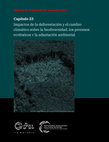
UN Sustainable Development Solutions Network (SDSN) eBooks, Jun 2, 2022
Sobre el Panel Científico por la Amazonía (PCA) El Panel Científico por la Amazonía es una inicia... more Sobre el Panel Científico por la Amazonía (PCA) El Panel Científico por la Amazonía es una iniciativa sin precedentes convocada bajo los auspicios de la Red de Soluciones para el Desarrollo Sostenible (SDSN) de las Naciones Unidas. El SPA está compuesto por más de 200 científicos e investigadores destacados de los ocho países amazónicos, la Guayana Francesa y socios globales. Estos expertos se reunieron para debatir, analizar y ensamblar el conocimiento acumulado de la comunidad científica, los pueblos Indígenas y otros actores que viven y trabajan en la Amazonía. El Panel está inspirado en el Pacto de Leticia por la Amazonía. Este es el primer informe de su tipo que proporciona una evaluación científica exhaustiva, objetiva, abierta, transparente, sistemática y rigurosa del estado de los ecosistemas de la Amazonía, las tendencias actuales y sus implicaciones para el bienestar a largo plazo de la región, así como oportunidades y opciones relevantes de políticas para la conservación y el desarrollo sostenible.
Experiences and lessons learned in the construction of a new paradigm of integrated fire management in Venezuela.&#160
Chapter 23: Impacts of deforestation and climate change on biodiversity, ecological processes, and environmental adaptation
UN Sustainable Development Solutions Network (SDSN) eBooks, Nov 12, 2021
This chapter presents observed and predicted impacts of climate change on Amazonian ecosystems, f... more This chapter presents observed and predicted impacts of climate change on Amazonian ecosystems, focusing on biodiversity, ecosystem services, carbon cycling, fisheries, and emissions from biomass burning. It also considers climate and land-use change feedbacks and highlights knowledge gaps to better understand these complex interactions.
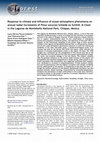
iForest - Biogeosciences and Forestry
The Lagunas de Montebello National Park, Chiapas, Mexico, is one of the most important protected ... more The Lagunas de Montebello National Park, Chiapas, Mexico, is one of the most important protected areas in terms of ecology and the provision of ecosystem services in the state of Chiapas; however, it lacks long-term climate information to support comprehensive plans for the conservation of endangered species and ecosystem restoration actions. The objectives of this work were to analyze: (i) the interannual variability of the annual rings of Pinus oocarpa Schiede in the Lagunas de Montebello National Park, as influenced by climate; and (ii) the ocean-atmosphere phenomena influence on both the interannual variability of the total ring-width series. A dendrochronological series of P. oocarpa was built for the period 1857-2018 (162 years), which indicates the presence of extreme hydroclimatic events in the region. Of these, the 1998 drought was a milestone for the management of this natural area due to the high-intensity fires that affected the area and caused unprecedented ecological, social, and economic damage in the site history. The climatic variables with the greatest influence on the annual radial increase of the species are precipitation and maximum temperature in winter-spring, when growth is positively associated with precipitation and negatively associated with temperature, attributed to increases in evapotranspiration. El Niño Southern Oscillation was the phenomenon with the highest correlation with climatic variability and the radial growth of the species, in frequencies of less than five years, although the positive influence of the Atlantic Multidecadal Oscillation was also assessed annually. Global warming, characterized by increasing temperature, threatens the persistence of plant communities in the study area; therefore, knowing its impact on the growth of species of economic importance is essential to support conservation actions.
Tropical Forest Issues, Nov 10, 2022
Traditional burning by the indigenous Pemón people in conucos (shifting cultivation areas). Photo... more Traditional burning by the indigenous Pemón people in conucos (shifting cultivation areas). Photo: Ruth Salazar-Gascón *Very sadly, Bernardo Ancidey passed away from Covid-19 prior to publication of this article. He will be greatly missed. Condolences to his family and friends.
Tropical Forest Issues
In 2020, intense wildfires affected 487,000 ha in the Paraná Delta. The government responded by r... more In 2020, intense wildfires affected 487,000 ha in the Paraná Delta. The government responded by reinforcing fire suppression and control policies and tightening regulations that criminalized the use of fire. This negatively affected local communities and small livestock producers, who depend on the use of fire for their subsistence activities. This article summarizes for the first time the traditional use of fire in the area, and describes efforts to stimulate dialogue between local communities, environmental organizations and government agencies to share perspectives and come to a common agreement as to ways forward. Results indicate the islanders’ complex knowledge of the role of fire in the maintenance of the various grassland ecosystems, and show that dialogue can lead to effective and workable solutions.
Informe de evaluación de Amazonía 2021
La deforestación y la degradación forestal son el resultado de la interacción entre varios impuls... more La deforestación y la degradación forestal son el resultado de la interacción entre varios impulsores directos que a menudo operan en tándem. El bioma amazónico había perdido aproximadamente 870.000 km2 de su cobertura forestal original, principalmente debido a la expansión agrícola (pastizales y tierras de cultivo). Otros impulsores directos incluyen la apertura de nuevas carreteras, la construcción de represas hidroeléctricas, la explotación de minerales y petróleo y la urbanización.
Chapter 19: Drivers and ecological impacts of deforestation and forest degradation
Amazon Assessment Report 2021
This chapter discusses the main drivers of deforestation and forest degradation in the Amazon, pa... more This chapter discusses the main drivers of deforestation and forest degradation in the Amazon, particularly agricultural expansion, road construction, mining, oil and gas development, forest fires, edge effects, logging, and hunting. It also examines these activities’ impacts and synergies between them.










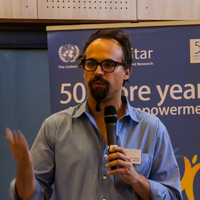
Uploads
Papers by Bibiana A Bilbao
El Informe RIOCCADAPT, Adaptación frente a los riegos del cambio climático en los países de la Red Iberoamericana de Oficinas de Cambio Climático (RIOCC), conformada por los países de lengua española y portuguesa de América, islas del Caribe y la Península Ibérica, es una iniciativa pionera financiada por el Programa ARAUCLIMA de la Cooperación Española y llevada a cabo por científicos de alto nivel, gestores y otros expertos. El objetivo de este informe ha sido brindar información exhaustiva desde todas las áreas del conocimiento, así como herramientas e indicadores que faciliten la toma efectiva de acciones para la adaptación al cambio climático de todos los países de la región.
En el presente Resumen para Responsables de Políticas se reporta en forma sucinta y asequible los alcances, conclusiones y recomendaciones recopiladas a lo largo de los 16 capítulos referente a las actuaciones sobre adaptación al cambio climático, de acuerdo a los principales sectores y sistemas de los países RIOCC. Se incluye además un análisis de las vulnerabilidades, así como de los riesgos e impactos más importantes del cambio climático y los casos de estudio que hemos considerado más ilustrativos y relevantes. Esperamos que este material sea de utilidad para la toma de decisiones y diseño de políticas que respondan a la prioridad y urgente necesidad de iniciar acciones que nuestros países requieren para una adaptación efectiva al cambio climático.
O Relatório RIOCCADAPT, Adaptação aos riscos das alterações climáticas nos países da Rede Ibero-Americana de Escritórios para as Alterações Climáticas (RIOCC), constituída pelos países de língua espanhola e portuguesa da América, ilhas das Caraíbas e Península Ibérica, é uma iniciativa pioneira financiada pelo Programa ARAUCLIMA de Cooperação Espanhola e levada a cabo por cientistas, gestores e outros peritos de alto nível. O objetivo deste relatório tem sido fornecer informações exaustivas de todas as áreas do conhecimento, bem como ferramentas e indicadores que facilitem uma ação eficaz de adaptação às mudanças climáticas em todos os países da região.
Este Resumo para Decisores Políticos relata de forma sucinta e acessível os âmbitos, conclusões e recomendações compiladas ao longo dos 16 capítulos relativos a ações de adaptação às alterações climáticas, de acordo com os principais sectores e sistemas dos países do RIOCC. Inclui também uma análise das vulnerabilidades, bem como os riscos e impactos mais importantes das alterações climáticas e os estudos de caso que consideramos mais ilustrativos e relevantes. Esperamos que este material seja útil para a tomada de decisões e conceção de políticas que respondam à necessidade prioritária e urgente de iniciar ações que os nossos países necessitam para uma adaptação eficaz às mudanças climáticas.
El Informe RIOCCADAPT, Adaptación frente a los riegos del cambio climático en los países iberoamericanos, financiado por el Programa ARAUCLIMA de la Cooperación Española, es una iniciativa pionera conformada por científicos de alto nivel, gestores y otros expertos para brindar información exhaustiva desde todas las áreas del conocimiento, así como herramientas e indicadores que faciliten la toma efectiva de acciones para la adaptación al cambio climático de todos los países de la región. En el presente capítulo 12, Incendios Forestales, se reúnen y analizan comparativamente por primera vez datos sobre el número, extensión, severidad y causa de los incendios que afectan a todos los países de la región RIOCC, la exposición y vulnerabilidad de las sociedades y ecosistemas ante estos eventos y las dimensiones ambientales y humanas del riesgo de incendios como consecuencia del cambio climático. Asimismo, se evalúan y se recogen experiencias sobre actuaciones en la gestión del riesgo de incendios y de adaptación al cambio climático. Se plantean, adicionalmente, una serie de medidas y programas de adaptación que consideramos indispensables para tratar de maximizar la resiliencia socio-ambiental en relación con los incendios forestales.
The RIOCCADAPT Report, Adaptation to the Risks of Climate Change in Ibero-American Countries, is a pioneer initiative funded by the ARAUCLIMA Programme of Spanish Cooperation. Many high-level scientists, managers and experts from a wide array of fields involved in the preparation of this Report that provides exhaustive information, as well as tools and indicators that facilitate effective action to adapt to climate change in all countries of the region.
Chapter 12, Forest Wildfires, collects and compares for the first-time data on the number, extent, severity and causes of fires that affect all countries in the RIOCC region. It also addresses the exposure and vulnerability of societies and ecosystems to these events, as well as the environmental and human dimensions of fire risk derived from climate change. This Chapter collects and discusses actual experiences on fire risk management and adaptation to climate change actions in Ibero-American countries. This Chapter includes a series of essential adaptation measures and programs, in order to maximize socio-environmental resilience concerning forest fires.
En los países desarrollados las políticas de mitigación de las emisiones continentales de GEI han incluido planes de reforestación y aforestación y nuevas tecnologías de manejo del suelo para reducir las emisiones desde los ET. Sin embargo, en los trópicos se mantienen altas tasas de deforestación y transformación de la vegetación y de los suelos, que conllevan a una emisión neta a nivel global entre 1
y 2 Pg C año-1 (Houghton et al., 2012; Baccini et al., 2012). El Neotrópico posee la tasa de deforestación más alta del globo (Pan et al., 2011; Baccini et al., 2012; De Sy et al., 2015; Román-Cuesta et al., 2016). Si bien los procesos de cambio del paisaje en América Tropical están ocurriendo a gran escala principalmente en la Cuenca Amazónica sensu stricto (específicamente en la región central de Brasil), Venezuela es un país de vital importancia, por ser uno de los países neotropicales con mayor proporción de bosques en relación a su territorio. Actualmente los estimados indican que entre el 50% y el 55% del territorio venezolano está ocupado por bosques (Bevilacqua et al., 2002; FRA, 2010; Pacheco et al., 2011a; FRA, 2015), el 90% de ellos aún con grados de intervención humana medios a bajos (Oliveira-Miranda et al., 2010; Pacheco et al., 2014).
Venezuela posee una gran diversidad de ecosistemas que son importantes en términos del ciclo regional y global del carbono, como la gran proporción de sabanas en la región de los Llanos del Orinoco que ocupan aproximadamente un cuarto de la superficie del país (Duno et al., 2006). Allí también se concentra una buena parte de las actividades agropecuarias. Estas sabanas contienen una diversidad de comunidades, que van desde los bosques deciduos y semideciduos del norte de la región llanera y el piedemonte andino, hasta las sabanas inundables de los llanos bajos del estado Apure, pasando por las sabanas bien drenadas arboladas presentes principalmente en los estados Cojedes, Guárico, Anzoátegui y Monagas. Los Llanos del Orinoco contienen también una extensa red de bosques de galería, de sistemas de bosquetes o matas, y de humedales con y sin palmas, que le otorgan una gran complejidad al paisaje. En este complejo de ecosistemas, el fuego se presenta con frecuencia contribuyendo con las emisiones regionales de GEI. Adicionalmente, la frontera agrícola y pecuaria se expande sostenidamente.
Venezuela también posee una orografía accidentada, sobre todo en la región costera y occidente del país, y en la Guayana venezolanaI.4.1. Existen por lo tanto importantes gradientes ambientales relacionados con los accidentes orográficos que le otorgan variabilidad a los patrones espaciales de la precipitación y las temperaturas. Así, Venezuela posee zonas semiáridas en la región costera, en algunos casos como efecto de la sombra de lluvia de las cordilleras, bosques montanos en los piédemontes y laderas de las montañas, selvas nubladas, y subpáramos y páramos donde la altura los favorece. Es importante conocer el papel que cumple esta diversidad de ecosistemas en el ciclo del carbono a nivel nacional, regional y global. Para ello se requiere en primer lugar conocer la extensión de cada sistema con la mayor exactitud posible y conocer los inventarios de carbono asociados con estos sistemas. Los inventarios incluyen: la biomasa viva y muerta, aérea y subterránea, especialmente de la vegetación que es el compartimiento más dinámico dentro de los sistemas continentales; las formas y cantidades de compuestos de carbono en el suelo, siendo el carbono orgánico del suelo (COS) el más importante. En segundo lugar, se deben conocer los flujos de intercambio con la atmósfera, considerando que los más cuantiosos son la productividad primaria y la respiración (incluyendo las pérdidas por descomposición de la biomasa y la descomposición del COS). Otros flujos importantes provienen de la actividad del fuego, de la transformación de un tipo de vegetación en otro, o de la expansión de las fronteras agropecuaria y/o urbana.
Por otro lado, también interesa conocer los impactos del cambio climático sobre la dinámica de los ET y su biodiversidad. Para ello se requiere en primer término conocer los patrones de diversidad que existen en un momento dado, la presencia y extensión de especies invasoras, y realizar un seguimiento que permita identificar posibles cambios. Identificar aspectos de la vulnerabilidad de los ET permite a su vez modelar cambios potenciales ante los escenarios futuros del cambio climático.
"Científica Parupa, CVG (Corporación Venezolana de Guayana), Gran Sabana, Parque Nacional Canaima, Venezuela, es la primera reunión del proyecto financiado por la Academia Británica (British Academy), organización de Investigación del Reino Unido, con el objetivo de:"
"“desarrollar un ‘caso’ para integrar las prácticas indígenas del fuego dentro de las políticas gubernamentales sobre el manejo del fuego”"
"El proyecto surge a partir de la colaboración entre la Dra. Jay Mistry de la Universidad Royal Holloway de Londres, Reino Unido y de la Dra. Bibiana Bilbao de la Universidad Simón Bolívar, Venezuela, quienes tienen una gran experiencia al trabajar con comunidades indígenas en Brasil, Región Esequiba y Venezuela, particularmente en el tema sobre el manejo del fuego."
"Con el fin de lograr los objetivos del proyecto, desde enero de 2015 hasta diciembre de 2017, y enfocándose en Venezuela, Brasil y Región Esequiba, el proyecto tiene planteadas las siguientes actividades:"
" Organizar talleres para compartir lecciones y perspectivas;"
" Recopilar información y revisión de literatura;"
" Facilitar la realización de pequeños videos participativos indígenas sobre el manejo del fuego;"
" Utilización de técnicas de teledetección con sensores remotos para evaluar el grado e impacto del fuego, y;"
" Emprender una serie de talleres y entrevistas con los tomadores de decisiones."
"Los objetivos de la primera reunión fueron:"
" Compartir las experiencias y lecciones aprendidas sobre las necesidades y restricciones que existen en el manejo del fuego por las comunidades indígenas."
" Desarrollar un discurso compartido sobre como el manejo del fuego de las comunidades indígenas puede ser apoyado y fortalecido."
" Desarrollar un plan de acción para llevar a cabo."